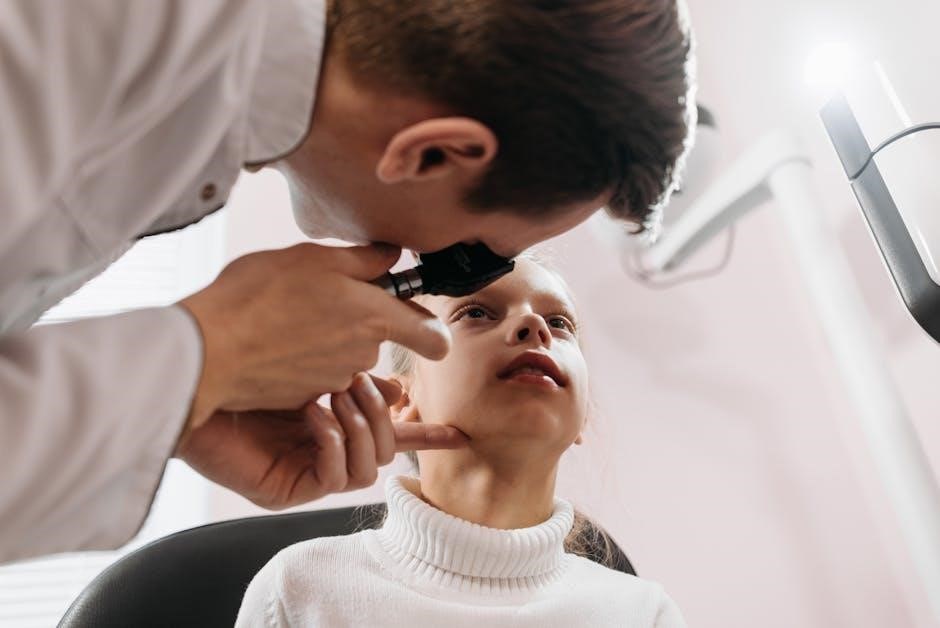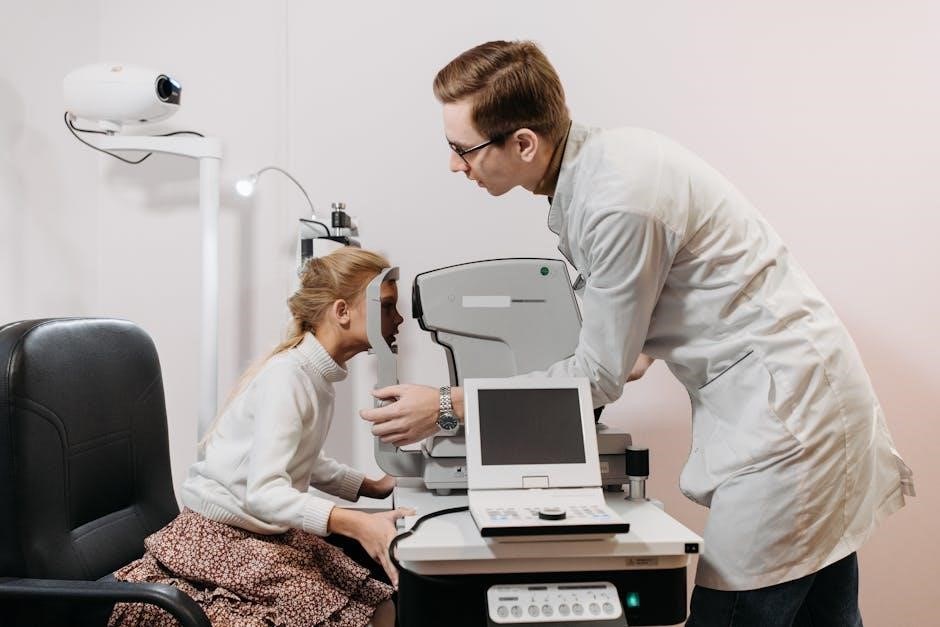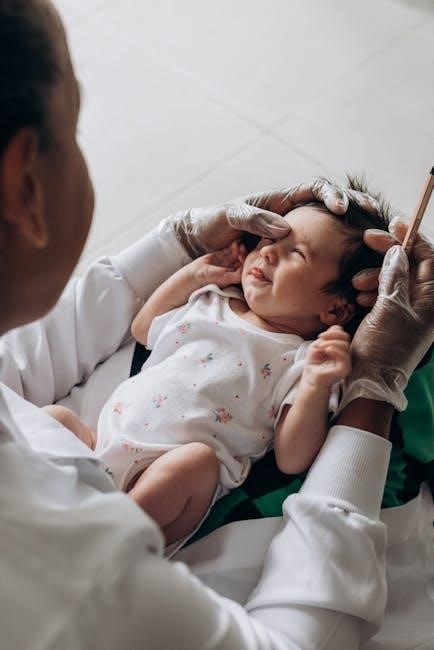Pediatric physical examination pdf provides comprehensive guidance on assessing children’s health, utilizing accurate techniques and tools, within a clinical setting, for medical professionals, using various resources and methods effectively always.
Importance of Accurate Physical Examination in Pediatrics
The importance of accurate physical examination in pediatrics cannot be overstated, as it plays a crucial role in diagnosing and managing various health conditions in children. A thorough physical examination helps healthcare professionals to identify potential health problems early on, which can significantly improve treatment outcomes. According to the pediatric physical examination pdf, accurate physical examination is essential for assessing the overall health and well-being of children, from infancy to adolescence. It involves evaluating various bodily systems, including the respiratory, cardiovascular, and neurological systems, to detect any abnormalities or signs of illness. By conducting regular and accurate physical examinations, healthcare professionals can provide timely and effective interventions, preventing long-term complications and promoting optimal health outcomes for children. This emphasizes the need for healthcare professionals to develop and refine their physical examination skills to provide high-quality care for pediatric patients.

Components of Pediatric Physical Examination
Pediatric physical examination pdf outlines essential components, including inspection, palpation, and auscultation, for medical professionals to assess children’s health effectively always using various methods.
History Taking and Physical Examination Techniques
Pediatric physical examination pdf emphasizes the importance of effective history taking and physical examination techniques in assessing children’s health. The document provides guidance on how to take a comprehensive medical history, including questions to ask and information to gather. It also outlines various physical examination techniques, such as inspection, palpation, and auscultation, and explains how to use them to assess different body systems. Additionally, the pdf discusses the importance of observation and communication skills in pediatric physical examination, and provides tips on how to make children feel comfortable and relaxed during the examination. By using these techniques, medical professionals can gather accurate and reliable information about a child’s health, and make informed decisions about diagnosis and treatment. The pdf is a valuable resource for medical students, residents, and practicing physicians who want to improve their skills in pediatric physical examination.

Age-Specific Physical Examination
Pediatric physical examination pdf outlines age-specific examination techniques for infants, children, and adolescents, using various assessment methods and tools effectively always and accurately.
Physical Examination of Infants and Neonates
The physical examination of infants and neonates is a critical component of pediatric care, requiring specialized skills and techniques. According to the pediatric physical examination pdf, a thorough examination of newborns and infants includes assessment of vital signs, overall appearance, and behavior. The pdf guide provides detailed instructions on how to perform a physical examination of infants and neonates, including inspection, palpation, and auscultation. It also emphasizes the importance of considering the infant’s age, weight, and medical history when interpreting physical examination findings. Additionally, the pdf discusses the unique aspects of physical examination in neonates, such as assessing reflexes and evaluating for congenital anomalies. By following the guidelines outlined in the pediatric physical examination pdf, healthcare providers can develop the skills and confidence needed to perform accurate and effective physical examinations of infants and neonates. This enables them to provide high-quality care and identify potential health issues early on.
Physical Examination of Children and Adolescents
The physical examination of children and adolescents is a dynamic process that evolves as the child grows and develops. According to the pediatric physical examination pdf, this examination should be tailored to the child’s age, developmental stage, and medical history. The pdf guide provides a comprehensive outline of the physical examination, including assessment of vital signs, growth and development, and body systems. It also discusses the importance of using age-appropriate communication skills and techniques to put the child at ease and facilitate a thorough examination. The physical examination of children and adolescents should also include an assessment of their mental and emotional health, as well as their social and environmental circumstances. By using the pediatric physical examination pdf as a resource, healthcare providers can develop the skills and knowledge needed to perform accurate and effective physical examinations of children and adolescents, from early childhood through adolescence. This enables them to provide high-quality care and support the child’s overall health and well-being.
Body System Examination
Systematic examination of pediatric patients involves assessing various body systems, using pediatric physical examination pdf guidelines, to identify potential health issues, accurately and effectively always.
Examination of the Respiratory System
The examination of the respiratory system is a crucial component of the pediatric physical examination, as respiratory issues are common in children. According to the pediatric physical examination pdf, a thorough assessment of the respiratory system involves inspecting the chest, listening to breath sounds, and evaluating respiratory rate and rhythm. The examiner should also note any signs of respiratory distress, such as nasal flaring, retractions, or grunting. Additionally, the pediatric physical examination pdf provides guidance on assessing lung sounds, including wheezes, crackles, and rhonchi, which can indicate various respiratory conditions. By following the guidelines outlined in the pediatric physical examination pdf, healthcare providers can effectively evaluate the respiratory system and identify potential issues in pediatric patients. This information is essential for providing accurate diagnoses and developing effective treatment plans for children with respiratory conditions. Regular examination of the respiratory system is vital for maintaining optimal health in pediatric patients.
Examination of the Cardiovascular System
The pediatric physical examination pdf provides a comprehensive guide to examining the cardiovascular system in children; This involves assessing heart rate, rhythm, and blood pressure, as well as evaluating the peripheral pulses and capillary refill time. The examiner should also listen to heart sounds, noting any murmurs or abnormal sounds, and assess the jugular venous distension. According to the pediatric physical examination pdf, a thorough cardiovascular examination is essential for detecting potential issues, such as congenital heart defects or cardiac arrhythmias. The pdf outlines the necessary steps for a complete cardiovascular examination, including inspection, palpation, and auscultation. By following these guidelines, healthcare providers can effectively evaluate the cardiovascular system and identify potential problems in pediatric patients. Regular examination of the cardiovascular system is crucial for maintaining optimal health and detecting potential issues early on, allowing for prompt treatment and intervention. This examination is a critical component of pediatric care.

Telehealth in Pediatric Physical Examination
Telehealth enhances pediatric physical examination pdf accessibility, convenience, and remote monitoring capabilities effectively always.
Benefits and Limitations of Telehealth in Pediatric Care
Telehealth in pediatric care offers numerous benefits, including increased accessibility and convenience for patients and their families, as well as remote monitoring capabilities, which can lead to better health outcomes. The use of telehealth can also reduce the need for in-person visits, which can be especially beneficial for children with chronic conditions or those living in rural areas. However, there are also limitations to telehealth, such as technical issues and the potential for misdiagnosis. Additionally, some pediatric conditions may require in-person evaluation and treatment, highlighting the need for a balanced approach to telehealth. Overall, the benefits and limitations of telehealth in pediatric care must be carefully considered to ensure that patients receive high-quality care. By understanding these factors, healthcare providers can effectively integrate telehealth into their practice and improve patient outcomes. This balance is crucial for optimal pediatric care.

Resources for Pediatric Physical Examination
Pediatric physical examination pdf and online resources provide valuable guidance and support for healthcare professionals, utilizing various tools and methods effectively always and accurately.
Pediatric Physical Examination Handbook and Guidelines
A pediatric physical examination handbook is a comprehensive resource that provides healthcare professionals with the necessary tools and guidelines to perform accurate and effective physical examinations on children. The handbook typically includes detailed information on the physical examination process, including the assessment of various body systems and the identification of potential health problems. Online resources, such as pediatric physical examination pdf files, can also provide valuable guidance and support for healthcare professionals. These resources may include printable checklists, assessment templates, and other tools to help streamline the physical examination process. By utilizing these resources, healthcare professionals can ensure that they are providing high-quality care to their young patients. The handbook and guidelines are essential for healthcare professionals to stay up-to-date on the latest best practices and recommendations for pediatric physical examinations, and to provide the best possible care for their patients.
